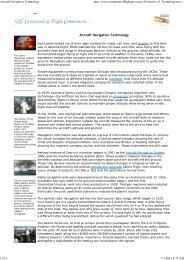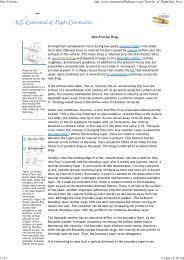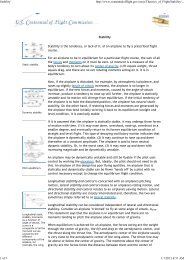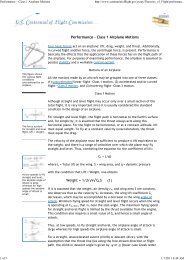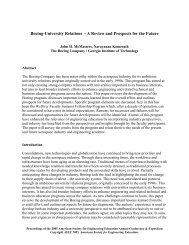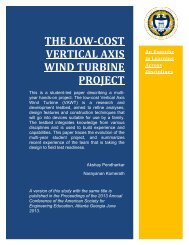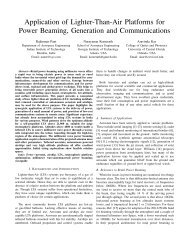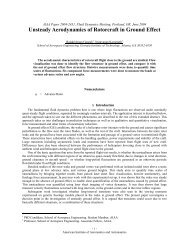Tip Vortex Formation and Evolution to the Near Wake of a Rotor in ...
Tip Vortex Formation and Evolution to the Near Wake of a Rotor in ...
Tip Vortex Formation and Evolution to the Near Wake of a Rotor in ...
You also want an ePaper? Increase the reach of your titles
YUMPU automatically turns print PDFs into web optimized ePapers that Google loves.
<strong>Tip</strong> <strong>Vortex</strong> <strong>Formation</strong> <strong>and</strong> <strong>Evolution</strong> <strong>to</strong> <strong>the</strong> <strong>Near</strong> <strong>Wake</strong> <strong>of</strong> a Ro<strong>to</strong>r <strong>in</strong> Forward FlightOliver D. Wonggt5071c@prism.gatech.eduNarayanan M. Komerathnarayanan.komerath@ae.gatech.eduSchool <strong>of</strong> Aerospace Eng<strong>in</strong>eer<strong>in</strong>gGeorgia Institute <strong>of</strong> TechnologyAtlanta, GA 30332Realistic models <strong>of</strong> <strong>the</strong> formation, structure <strong>and</strong> evolution <strong>of</strong> tip vortices are essential <strong>to</strong> predict ro<strong>to</strong>r bladeaeroacoustics. Velocity measurements are reported here on tip vortex formation <strong>and</strong> evolution <strong>to</strong> <strong>the</strong> near wake froma teeter<strong>in</strong>g, untwisted, square-tipped, two-bladed NACA0015 ro<strong>to</strong>r <strong>in</strong> low-speed forward flight. Given assuredperiodicity <strong>and</strong> appropriate measurement techniques, vortex formation results confirm observations made <strong>in</strong> <strong>the</strong>1980s. Circumferential velocity pr<strong>of</strong>iles are observed as early as x/c = 0.47, grow<strong>in</strong>g <strong>in</strong> strength <strong>and</strong> core radius up<strong>to</strong> x/c <strong>of</strong> 1.06. The pr<strong>of</strong>iles <strong>of</strong> circumferential velocity manifest <strong>the</strong> rollup <strong>of</strong> discrete vortex filaments. The effect <strong>of</strong>seed particle dynamics on <strong>the</strong> accuracy <strong>of</strong> vortex measurements <strong>in</strong> <strong>the</strong> near wake is studied <strong>to</strong> verify accuracy. Thewake structure <strong>and</strong> <strong>the</strong> tip vortex properties up <strong>to</strong> 488° <strong>of</strong> wake age are presented. Harmonic variations are seen <strong>in</strong><strong>the</strong> tip vortex core axial velocity. A strong spanwise velocity is seen on <strong>the</strong> pressure <strong>and</strong> suction sides <strong>of</strong> <strong>the</strong> blade.The core axial velocity appears <strong>to</strong> approach tip speed at orig<strong>in</strong>, <strong>and</strong> <strong>the</strong> core circumferential velocity rema<strong>in</strong>sconstant for a large distance after formation. The equations <strong>of</strong> motion describ<strong>in</strong>g seed particle motion <strong>in</strong> a 2D vortexwere numerically <strong>in</strong>tegrated <strong>to</strong> quantify <strong>the</strong> velocity error <strong>of</strong> LDV measurements <strong>of</strong> <strong>the</strong> near-wake vortexcharacteristics due <strong>to</strong> seed particle dynamics. For a vortex strength <strong>of</strong> 0.75 m 2 /s typical <strong>of</strong> ro<strong>to</strong>r tests at a tip Machnumber <strong>of</strong> 0.15, <strong>the</strong> error <strong>in</strong> circumferential velocity error due <strong>to</strong> lag <strong>of</strong> particles between 1 <strong>and</strong> 5µm, is seen <strong>to</strong> havean upper bound <strong>of</strong> 2%.I. IntroductionThe ro<strong>to</strong>r blade tip vortex is perhaps <strong>the</strong> most prom<strong>in</strong>ent<strong>and</strong> critical aspect <strong>of</strong> ro<strong>to</strong>rcraft aerodynamics <strong>and</strong>aeroacoustics. Yet <strong>the</strong>re is substantial uncerta<strong>in</strong>ty <strong>to</strong>dayabout <strong>the</strong> precise manner <strong>of</strong> its orig<strong>in</strong>, structure <strong>and</strong>evolution. In this paper, we study <strong>the</strong>se aspects us<strong>in</strong>g<strong>the</strong> vortex trailed from <strong>the</strong> tip <strong>of</strong> a NACA 0015 ro<strong>to</strong>rblade at 10 degrees collective pitch <strong>in</strong> a w<strong>in</strong>d tunnel.This paper deals with two aspects. The first is <strong>to</strong>describe measurements <strong>of</strong> <strong>the</strong> velocity field surround<strong>in</strong>g<strong>the</strong> blade-tip. These data, along with previousmeasurements <strong>of</strong> <strong>the</strong> tip-vortex properties <strong>in</strong> <strong>the</strong> nearwake, complete a dataset describ<strong>in</strong>g <strong>the</strong> vortex from<strong>in</strong>ception through evolution <strong>in</strong> <strong>the</strong> near wake [1-2]. Thesecond aspect is <strong>the</strong> velocity error <strong>in</strong> measurement <strong>of</strong><strong>the</strong> near-wake vortex properties due <strong>to</strong> seed particledynamics. Laser velocimetry (LV) measures <strong>the</strong>velocity <strong>of</strong> seed particles convected by <strong>the</strong> flow <strong>to</strong>ascerta<strong>in</strong> <strong>the</strong> fluid velocity. However, particles entra<strong>in</strong>ed<strong>in</strong> vortices are subject <strong>to</strong> centrifugal forces from rotation<strong>of</strong> <strong>the</strong> fluid. To determ<strong>in</strong>e <strong>the</strong> accuracy <strong>of</strong> <strong>the</strong>measurements <strong>of</strong> <strong>the</strong> tip-vortex characteristics <strong>in</strong> <strong>the</strong>near-wake, it is necessary <strong>to</strong> quantify <strong>the</strong> error<strong>in</strong>troduced by <strong>the</strong> centrifugal force.II. Previous WorkII.1 Previous work on tip vortex velocity fieldsThompson et al [3] used LV <strong>to</strong> exam<strong>in</strong>e <strong>the</strong> formationprocess as well as <strong>the</strong> vortex properties <strong>in</strong> <strong>the</strong> near-wake<strong>of</strong> a s<strong>in</strong>gle-bladed ro<strong>to</strong>r <strong>in</strong> <strong>the</strong> Georgia Tech 9-foothover facility <strong>in</strong> <strong>the</strong> mid-1980s. In this facility, a wake<strong>in</strong>duc<strong>to</strong>r ref<strong>in</strong>ed by trial <strong>and</strong> error enabled ro<strong>to</strong>roperation over a specified range <strong>of</strong> test conditions with<strong>the</strong> problems <strong>of</strong> vortex imp<strong>in</strong>gement on facility walls.Under <strong>the</strong>se conditions, ro<strong>to</strong>r-synchronized laser sheetvisualization howed that <strong>the</strong> vortex followed aprecisely-repeat<strong>in</strong>g trajec<strong>to</strong>ry for at least <strong>the</strong> first 360degrees <strong>and</strong> probably <strong>the</strong> first 540 degrees <strong>of</strong> vortexage. Us<strong>in</strong>g m<strong>in</strong>eral oil seed<strong>in</strong>g which showed some“sp<strong>in</strong>out” (discussed later <strong>in</strong> this paper), <strong>the</strong>y sliced <strong>the</strong>wake radially us<strong>in</strong>g an argon ion laser sheet,approximately 1mm thick, <strong>and</strong> strobed <strong>the</strong> laser beamus<strong>in</strong>g a chopper wheel driven on a mo<strong>to</strong>r synchronized<strong>to</strong> <strong>the</strong> ro<strong>to</strong>r shaft. The ro<strong>to</strong>r was operated at 600rpm. A35 mm camera set on long exposure captured <strong>the</strong> vortexcores clearly for at least <strong>the</strong> first 3 turns. Aperiodicity(jitter) <strong>of</strong> even one core radius would have moved <strong>the</strong>brightest regions <strong>of</strong> <strong>the</strong> pho<strong>to</strong>graph (<strong>the</strong> heavily-seededregion at <strong>the</strong> edge <strong>of</strong> <strong>the</strong> core) across <strong>the</strong> darkest region<strong>the</strong> core center, smear<strong>in</strong>g out <strong>the</strong> pho<strong>to</strong>s. Withperiodicity thus assured, <strong>the</strong>y used sub-micron particles<strong>of</strong> <strong>in</strong>cense smoke <strong>to</strong> seed <strong>the</strong> core <strong>of</strong> <strong>the</strong> tip vortex, <strong>and</strong>measured each <strong>of</strong> <strong>the</strong> 3 components <strong>of</strong> velocity, <strong>in</strong> turn,across <strong>the</strong> vortex us<strong>in</strong>g a specially-designed Remote-Aligned Off-Axis Receiver [4]. With this arrangement,<strong>the</strong>y obta<strong>in</strong>ed fairly uniform seed particle arrival ratesacross <strong>the</strong> entire tip vortex. They found that dur<strong>in</strong>gformation, <strong>the</strong> vortex achieved its maximum strength ata x/c <strong>of</strong> 0.5 <strong>and</strong> 0.6 for C T values <strong>of</strong> 0.0057 <strong>and</strong> 0.0022Copyright © American Helicopter Society. Presented at <strong>the</strong> 57 th AHS Forum, June 2001
espectively. Thompson also observed secondaryfeatures <strong>in</strong> <strong>the</strong> circumferential velocity pr<strong>of</strong>iles for earlywake ages. These were not unders<strong>to</strong>od at <strong>the</strong> time; atpresent we postulate that <strong>the</strong>se are a manifestation <strong>of</strong> <strong>the</strong>rollup <strong>of</strong> discrete vortical filaments dur<strong>in</strong>g <strong>the</strong> formation<strong>of</strong> <strong>the</strong> tip vortex. However, Thompson’s flowvisualization <strong>and</strong> measurements showed that <strong>the</strong> tipvortex <strong>of</strong> a ro<strong>to</strong>r does persist with much <strong>of</strong> its <strong>in</strong>itialstrength for large vortex ages.Br<strong>and</strong> et al [5,6] <strong>and</strong> Liou et al [7-9] exam<strong>in</strong>ed vortextrajec<strong>to</strong>ries <strong>and</strong> dynamics <strong>of</strong> <strong>the</strong> two-bladed ro<strong>to</strong>r used<strong>in</strong> <strong>the</strong> present paper, <strong>in</strong> forward flight <strong>in</strong> <strong>the</strong> same w<strong>in</strong>dtunnel. They showed, aga<strong>in</strong>, that vortex trajec<strong>to</strong>riesrepeated with precise periodicity, provided wakeimp<strong>in</strong>gement on <strong>the</strong> tunnel floor, <strong>and</strong> wakerecirculation, were prevented by go<strong>in</strong>g <strong>to</strong> sufficientlyhigh advance ratio (>0.06 <strong>in</strong> this experimentalconfiguration). Aga<strong>in</strong>, <strong>the</strong> vortex was seen <strong>to</strong> ma<strong>in</strong>ta<strong>in</strong>much <strong>of</strong> its <strong>in</strong>itial strength for vortex ages over 400degrees, which was <strong>the</strong> limit <strong>of</strong> <strong>the</strong>ir <strong>in</strong>terest because<strong>the</strong>y were study<strong>in</strong>g ro<strong>to</strong>r vortex/airframe <strong>in</strong>teraction.Komerath et al [10] extended <strong>the</strong> s<strong>in</strong>gle-bladed ro<strong>to</strong>rwith a double-swept blade tip <strong>in</strong> <strong>the</strong> 9-foot hover facilityat Georgia Tech <strong>to</strong> study effects at high pitch angles.Dur<strong>in</strong>g <strong>the</strong>ir experiments, <strong>the</strong>y observed that at certa<strong>in</strong>conditions, <strong>the</strong> tip vortices imp<strong>in</strong>ged on <strong>the</strong> edge <strong>of</strong> <strong>the</strong>wake <strong>in</strong>duc<strong>to</strong>r <strong>and</strong> recirculated <strong>in</strong> <strong>the</strong> facility: this wasassociated with <strong>the</strong> development <strong>of</strong> severe aperiodicjitter <strong>of</strong> <strong>the</strong> vortex trajec<strong>to</strong>ries.Funk et al [11] conducted extensive measurements <strong>of</strong><strong>the</strong> flowfield between <strong>the</strong> 2-bladed ro<strong>to</strong>r <strong>and</strong> a w<strong>in</strong>g <strong>in</strong><strong>the</strong> John Harper w<strong>in</strong>d tunnel. Although vortextrajec<strong>to</strong>ries were substantially altered by w<strong>in</strong>g<strong>in</strong>teraction, <strong>the</strong> results on periodic repeatability <strong>of</strong>vortex locations, <strong>and</strong> persistence <strong>of</strong> vortices <strong>to</strong> largeages, both rema<strong>in</strong>ed unchanged.Carradonna et al [12,13] visualized <strong>the</strong> wake <strong>of</strong> a 2-bladed ro<strong>to</strong>r <strong>in</strong> axial climb <strong>in</strong> <strong>the</strong> 30’x30’ Settl<strong>in</strong>gChamber <strong>of</strong> <strong>the</strong> 7’x 10’ w<strong>in</strong>d tunnel at Ames ResearchCenter. Aga<strong>in</strong> <strong>the</strong>y found that when wake recirculationwas prevented, <strong>the</strong> vortex trajec<strong>to</strong>ries repeated quiteperfectly from cycle <strong>to</strong> cycle <strong>of</strong> blade motion, even as<strong>the</strong> climb velocity was brought <strong>to</strong>wards zero. <strong>Vortex</strong>cores were discernible by <strong>the</strong> seed particle patterns forseveral turns <strong>of</strong> <strong>the</strong> vortex, until merger betweenvortices smeared <strong>the</strong> patterns. From <strong>the</strong> above, it is quiteclear that <strong>the</strong> tip vortex <strong>of</strong> a ro<strong>to</strong>r persists over longvortex ages. Also, aperiodic “jitter” <strong>of</strong> vortices is not abasic fluid mechanical feature <strong>of</strong> ro<strong>to</strong>r wakes, providedrecirculation is avoided.McAlister [14-15] studied <strong>the</strong> velocity field <strong>in</strong> <strong>the</strong> nearwake <strong>of</strong> a two-bladed ro<strong>to</strong>r <strong>in</strong> hover us<strong>in</strong>g a 3-component laser velocimeter. The test conditions were aC t <strong>of</strong> 0.005 at 1100 <strong>and</strong> 550 RPM. He found that threechords downstream <strong>of</strong> <strong>the</strong> blade <strong>the</strong> vortex me<strong>and</strong>er wasless than one core diameter. The me<strong>and</strong>er <strong>in</strong>creased byan order <strong>of</strong> magnitude by <strong>the</strong> time vortex reached 180°<strong>of</strong> vortex age. He also noted that chang<strong>in</strong>g <strong>the</strong> rotationalspeed did not have an effect on <strong>the</strong> core diameter, <strong>the</strong>general appearance <strong>of</strong> <strong>the</strong> trail<strong>in</strong>g vortex, or <strong>the</strong>magnitude <strong>of</strong> <strong>the</strong> velocity components relative <strong>to</strong> <strong>the</strong>tip-speed.In <strong>the</strong> late 1990s, measurements were reported byLeishman et al [16] us<strong>in</strong>g a s<strong>in</strong>gle-bladed ro<strong>to</strong>r <strong>in</strong> ahover facility, us<strong>in</strong>g a 3-component laser velocimeter.These measurements <strong>in</strong>dicated rapid “diffusion” <strong>of</strong> <strong>the</strong>tip vortices with<strong>in</strong> <strong>the</strong> first 90 degrees <strong>of</strong> vortex age.Substantial aperiodicity was observed. Thesephenomena were attributed <strong>to</strong> turbulence <strong>in</strong> <strong>the</strong> core,<strong>and</strong> <strong>the</strong> rapid smear<strong>in</strong>g <strong>of</strong> <strong>the</strong> vortex velocity pr<strong>of</strong>iledata was described as turbulent diffusion [16]. However<strong>the</strong> data acquisition procedures used had taken noaccount <strong>of</strong> aperiodicity, rais<strong>in</strong>g <strong>the</strong> possibility thatvortex pr<strong>of</strong>ile data, averaged over several cycles, hadbecome severely smeared by cycle-<strong>to</strong>-cycle uncerta<strong>in</strong>ty<strong>in</strong> vortex position. Conlisk et al [17] showed byanalytical arguments based on orders <strong>of</strong> magnitude thatturbulent diffusion was not a plausible explanation forvortex decay <strong>of</strong> <strong>the</strong> rate reported <strong>in</strong> Ref. [16].Mahal<strong>in</strong>gam et al [18-20] conducted measurements on<strong>the</strong> advanc<strong>in</strong>g blade side (ABS) <strong>of</strong> <strong>the</strong> two-bladed ro<strong>to</strong>rused <strong>in</strong> this paper, <strong>in</strong> low-speed forward flight. Heshowed by flow visualization <strong>and</strong> LDV measurementsthat <strong>the</strong> ro<strong>to</strong>r flow field was periodic <strong>to</strong> better than 1° <strong>of</strong>ro<strong>to</strong>r azimuth at an advance ratios 0.1. Hav<strong>in</strong>gestablished periodicity <strong>to</strong> ensure <strong>the</strong> quality <strong>of</strong> <strong>the</strong> data,he studied <strong>the</strong> near-blade flowfield as well as <strong>the</strong> nearwake. In <strong>the</strong>se measurements, he observed strongspanwise velocities directed <strong>to</strong>wards <strong>the</strong> blade-tip onboth <strong>the</strong> suction <strong>and</strong> pressure sides <strong>of</strong> <strong>the</strong> blade. Thevelocities approached 40% <strong>of</strong> <strong>the</strong> tip-speed on <strong>the</strong>pressure side. Spanwise flow on <strong>the</strong> suction side wasmuch lower. Mahal<strong>in</strong>gam also observed secondaryeffects <strong>in</strong> <strong>the</strong> circumferential velocity pr<strong>of</strong>iles dur<strong>in</strong>gformation. He showed that <strong>the</strong> turbulence level <strong>in</strong>side<strong>the</strong> core was lower than that <strong>in</strong> <strong>the</strong> freestream, as mightbe expected <strong>in</strong> a region <strong>of</strong> favorable pressure gradient.Both <strong>the</strong> vortex strength <strong>and</strong> <strong>the</strong> axial velocity <strong>in</strong> <strong>the</strong>core were shown <strong>to</strong> persist out <strong>to</strong> more than 500 degrees<strong>of</strong> vortex age.II.2 Previous Work on Seed Particle InertiaAs previously mentioned, velocity measurementtechniques that rely on seed particles carried by a fluidCopyright © American Helicopter Society. Presented at <strong>the</strong> 57 th AHS Forum, June 2001
are subject <strong>to</strong> errors due <strong>to</strong> f<strong>in</strong>ite particle <strong>in</strong>ertia. In <strong>the</strong>case <strong>of</strong> laser velocimetry, <strong>the</strong> experimenter faces adilemma: light scatter<strong>in</strong>g from particles smaller than 1micron is generally difficult <strong>to</strong> capture accurately <strong>in</strong> <strong>the</strong>backscatter mode (light captured at <strong>the</strong> same lens whichis used <strong>to</strong> transmit <strong>the</strong> laser beams) over <strong>the</strong> largedistances used for laser velocimetry <strong>in</strong> ro<strong>to</strong>r facilities.Particles larger than one micron are believed <strong>to</strong>experience substantial centrifugal drift with respect <strong>to</strong><strong>the</strong> flow <strong>in</strong> <strong>the</strong> core <strong>of</strong> a tip vortex. Thompson et al[3,4]dealt with this problem by develop<strong>in</strong>g an Off-AxisScatter Receiver [4]. This device could be alignedremotely <strong>to</strong> stay focused on <strong>the</strong> measurement volume asit was traversed across a large facility, <strong>and</strong> capturescatter<strong>in</strong>g from sub-micron particles. This is howeverless convenient than us<strong>in</strong>g a backscatter LV system, <strong>and</strong>is difficult when <strong>the</strong> ro<strong>to</strong>r is near o<strong>the</strong>r objects whichblock <strong>the</strong> l<strong>in</strong>e <strong>of</strong> sight.It is <strong>the</strong>refore necessary <strong>to</strong> use larger particles, <strong>and</strong>quantify <strong>the</strong> error due <strong>to</strong> particle sp<strong>in</strong>out. Dr<strong>in</strong>g et al[21] has exam<strong>in</strong>ed <strong>the</strong> trajec<strong>to</strong>ries <strong>of</strong> particles <strong>in</strong> turb<strong>in</strong>ecascades. He concluded that <strong>the</strong> S<strong>to</strong>kes number (St) had<strong>the</strong> greatest <strong>in</strong>fluence on particle behavior. Fur<strong>the</strong>rmore,he determ<strong>in</strong>ed that particles with St ≤ 0.1 would veryclosely follow <strong>the</strong> streaml<strong>in</strong>es <strong>and</strong> particles with St > 10would be centrifuged across streaml<strong>in</strong>es. In ano<strong>the</strong>rstudy, Dr<strong>in</strong>g [22] <strong>in</strong>tegrated <strong>the</strong> equations <strong>of</strong> motion forparticles <strong>in</strong> several flows <strong>to</strong> provide guidance on LVseed particle size selection. The flows <strong>in</strong>cluded a turb<strong>in</strong>ecascade, a step deceleration <strong>and</strong> exponential <strong>and</strong>s<strong>in</strong>usoidal accelerations. He determ<strong>in</strong>ed that <strong>the</strong> S<strong>to</strong>kesnumber required <strong>to</strong> achieve 1% accuracy depended on<strong>the</strong> type <strong>of</strong> flow. In a turb<strong>in</strong>e cascade, he found that aS<strong>to</strong>kes number <strong>of</strong> less than 0.01 was required, but <strong>in</strong> as<strong>in</strong>usoidal flow 0.14 was <strong>to</strong>lerable.Dr<strong>in</strong>g, et al [23] <strong>and</strong> Kriebel [24] exam<strong>in</strong>ed <strong>the</strong> behavior<strong>of</strong> particles <strong>in</strong> centrifugal particle separa<strong>to</strong>rs. In <strong>the</strong>seflows, <strong>the</strong> gas experiences solid body rotation. This isanalogous <strong>to</strong> vortex core velocity pr<strong>of</strong>iles, except that<strong>the</strong> strong axial velocity is absent. Dr<strong>in</strong>g’s analysisassumed that <strong>the</strong> particle <strong>and</strong> gas velocity were equal.He also used several drag models <strong>in</strong>stead <strong>of</strong> assum<strong>in</strong>gthat S<strong>to</strong>kes relation holds. Dr<strong>in</strong>g [23] asserts: “axialvelocities do not alter <strong>the</strong> solution so long as <strong>the</strong>particle <strong>and</strong> fluid axial velocities are equal <strong>and</strong>constant.” Kriebel’s study did not place anyassumptions on <strong>the</strong> particle <strong>and</strong> fluid velocity. However,he used S<strong>to</strong>kes relation <strong>to</strong> estimate drag act<strong>in</strong>g on <strong>the</strong>particle. Comparison with experimental data is alsoprovided. Nei<strong>the</strong>r <strong>of</strong> <strong>the</strong>se analyses is valid <strong>in</strong> <strong>the</strong>potential velocity region outside <strong>the</strong> vortex core.Leishman [25] calculated <strong>the</strong> behavior <strong>of</strong> seed particles<strong>in</strong> a “des<strong>in</strong>gularized” vortex. His study used particlesrang<strong>in</strong>g from 0.5 <strong>to</strong> 2.0 µm <strong>and</strong> a vortex circulation <strong>of</strong>5.6 m 2 s -1 . Inside <strong>the</strong> vortex core, he predicted velocityerrors as high as 10% <strong>and</strong> 25% for <strong>the</strong> tangential <strong>and</strong>radial velocities, respectively, for <strong>the</strong> 2 µm particle. Thesmaller particles resulted <strong>in</strong> lower errors. His study alsoexam<strong>in</strong>ed particle count distribution. The highestparticle distributions occurred at r/R c <strong>of</strong> 1.7 for <strong>the</strong>0.5µm particles, 2.6 for <strong>the</strong> 1.0µm particles <strong>and</strong> 3.8 for<strong>the</strong> 2.0µm particles. Although <strong>in</strong>tended for ro<strong>to</strong>r tipvortex applications, this work did not consider <strong>the</strong>effects <strong>of</strong> <strong>the</strong> strong axial velocity <strong>in</strong> <strong>the</strong> core. It shouldbe noted here that <strong>the</strong> vortex strengths used byLeishman [25] are almost 5 times those encountered <strong>in</strong><strong>the</strong> present ro<strong>to</strong>r flowfield.The previous work on seed particle <strong>in</strong>ertia has beenfocused on 2-dimensional models <strong>of</strong> vortices. In <strong>the</strong>ro<strong>to</strong>r tip vortex core, as shown by Refs. [3-14], <strong>the</strong>re is avery substantial axial velocity. The result<strong>in</strong>g s<strong>in</strong>k-likeeffects on <strong>the</strong> flowfield should cause an <strong>in</strong>ward-directedradial fluid velocity, which should considerably <strong>in</strong>hibit<strong>the</strong> drift <strong>of</strong> particles out <strong>of</strong> <strong>the</strong> middle <strong>of</strong> <strong>the</strong> core, where<strong>the</strong> centrifugal acceleration is much lower than at <strong>the</strong>core edge. Consider<strong>in</strong>g experimental results obta<strong>in</strong>ed at<strong>the</strong> present authors’ labora<strong>to</strong>ry with cleanly-periodic,well-resolve vortices, it is evident that <strong>the</strong> estimates <strong>of</strong>seed-particle <strong>in</strong>ertia error cited, for example, <strong>in</strong> [25]convey an overconservative picture. This issue needs <strong>to</strong>be considered, <strong>and</strong> upper bounds are sought for <strong>the</strong>setypes <strong>of</strong> errors.III. Issues <strong>and</strong> objectives <strong>of</strong> present workIn <strong>the</strong> present work, <strong>the</strong> flowfield near <strong>the</strong> blade tip ismeasured, <strong>to</strong> exam<strong>in</strong>e <strong>the</strong> development <strong>of</strong> <strong>the</strong> tip vortex.These measurements are <strong>the</strong>n related <strong>to</strong> measurements<strong>of</strong> <strong>the</strong> vortex <strong>in</strong> <strong>the</strong> wake. M<strong>in</strong>eral oil seed<strong>in</strong>g is used.The dynamics <strong>of</strong> <strong>the</strong> seed particles are exam<strong>in</strong>ed <strong>in</strong> <strong>the</strong>context <strong>of</strong> velocity field error, <strong>and</strong> <strong>the</strong> observedevacuation <strong>of</strong> particles from <strong>the</strong> vortex core as vortexage <strong>in</strong>creases. Issues are:1.What are observed differences <strong>of</strong> ro<strong>to</strong>r tip vortexcores from fixed-w<strong>in</strong>g vortex cores?2. What is <strong>the</strong> nature <strong>of</strong> <strong>the</strong> nascent core?3. How does <strong>the</strong> vortex circulation change as <strong>the</strong> vortexdevelops over <strong>the</strong> blade tip?4. Are <strong>the</strong> predictions <strong>of</strong> error due <strong>to</strong> particle sp<strong>in</strong>-outvalid for ro<strong>to</strong>r tip vortices?5. Why does <strong>the</strong> vortex core become clear <strong>of</strong> seedparticles fur<strong>the</strong>r downstream?6. What are <strong>the</strong> implications for <strong>the</strong> evolution <strong>of</strong> <strong>the</strong>vortex fur<strong>the</strong>r downstream <strong>in</strong> <strong>the</strong> wake?The objective <strong>of</strong> <strong>the</strong> paper is <strong>to</strong> resolve <strong>the</strong>contradictions seen <strong>in</strong> <strong>the</strong> literature regard<strong>in</strong>g <strong>the</strong> aboveissues. It is noted that <strong>the</strong> results given here are limited<strong>to</strong> <strong>the</strong> <strong>in</strong>compressible flow regime. The blade used has aCopyright © American Helicopter Society. Presented at <strong>the</strong> 57 th AHS Forum, June 2001
square tip <strong>and</strong> is heavily tip-loaded due <strong>to</strong> <strong>the</strong> constantchord,rectangular planform. The Reynolds number <strong>of</strong><strong>the</strong> tests is high enough <strong>to</strong> <strong>in</strong>volve transition on <strong>the</strong>blades, <strong>and</strong> both <strong>the</strong> freestream turbulence <strong>in</strong>tensity(roughly 0.15%), <strong>the</strong> blade chord, collective pitch <strong>of</strong> 10degrees, <strong>and</strong> <strong>the</strong> surface roughness <strong>of</strong> <strong>the</strong> blade withrough grit over <strong>the</strong> lead<strong>in</strong>g edge up <strong>to</strong> quarter-chord,<strong>and</strong> <strong>the</strong> wooden surface aft <strong>of</strong> that, all contribute <strong>to</strong> <strong>the</strong>development <strong>of</strong> turbulent boundary layers. The seedparticles used are not monodisperse <strong>in</strong> size distribution,<strong>and</strong> some <strong>of</strong> <strong>the</strong>m are expected <strong>to</strong> be <strong>in</strong> <strong>the</strong> regimewhere <strong>the</strong> sp<strong>in</strong>out error must be considered. Except for<strong>the</strong> tip Mach number, <strong>the</strong>se are fairly realistic conditionsfor <strong>in</strong>terpretation <strong>and</strong> application <strong>of</strong> <strong>the</strong> results, as willbe seen.IV. Experimental SetupThese experiments were conducted <strong>in</strong> Georgia Tech’sJohn Harper W<strong>in</strong>d Tunnel. The facility is a closedcircuit tunnel with a 2.13m x 2.74m test section. Airspeed is cont<strong>in</strong>uously variable up <strong>to</strong> 60 m/s. Turbulencelevels are 0.2%. The ro<strong>to</strong>r shaft extends through <strong>the</strong> testsection ceil<strong>in</strong>g <strong>to</strong> <strong>the</strong> centerl<strong>in</strong>e <strong>of</strong> <strong>the</strong> tunnel, <strong>and</strong> istilted forward by 6° <strong>to</strong> simulate forward flight. Attached<strong>to</strong> this shaft is a two-bladed, teeter<strong>in</strong>g, untwisted,untapered, NACA 0015 ro<strong>to</strong>r. The radius <strong>and</strong> bladechord are 9.457m <strong>and</strong> 85.7mm respectively. Testconditions for <strong>the</strong>se experiments were a ro<strong>to</strong>r RPM <strong>of</strong>1050 <strong>and</strong> an advance ratio <strong>of</strong> 0.10. An optical sensor isused <strong>to</strong> generate a TTL 1/rev pulse used for phaseaverag<strong>in</strong>g measurements.Figure 1 - Forward flight experimental setupS<strong>in</strong>gle velocity component measurements were madeus<strong>in</strong>g a laser velocimeter (LV) on <strong>the</strong> advanc<strong>in</strong>g bladeside (ABS). The multi-l<strong>in</strong>e output from a 5W argon-ionlaser is used <strong>to</strong> power <strong>the</strong> laser Doppler velocimeter.The green l<strong>in</strong>e (514.5nm) is separated <strong>and</strong> <strong>the</strong>n split <strong>in</strong><strong>to</strong>two beams, frequency shifted <strong>and</strong> coupled <strong>in</strong> <strong>to</strong> a fiberoptic probe <strong>in</strong> a TSI Colorburst module. The probe ismounted <strong>in</strong> <strong>the</strong> test section <strong>to</strong> a three-axis l<strong>in</strong>eartraverse. The probe <strong>and</strong> traverse are well outside <strong>of</strong> <strong>the</strong>ro<strong>to</strong>r wake <strong>to</strong> m<strong>in</strong>imize <strong>the</strong>ir effects on <strong>the</strong> ro<strong>to</strong>r flowfield. All <strong>of</strong> <strong>the</strong>se measurements were made <strong>in</strong>backscatter mode. The measurement volume is ellipsoidwith a diameter <strong>of</strong> 90.5µm <strong>and</strong> a length <strong>of</strong> 1.31mm. Themeasurement grid consisted <strong>of</strong> a course grid with5.08mm steps <strong>and</strong> a f<strong>in</strong>er grid centered on <strong>the</strong> blade-tipwith 2.54mm steps. The orig<strong>in</strong> for <strong>the</strong>se measurementsis located at <strong>the</strong> blade-tip trail<strong>in</strong>g edge when ψ = 90°.One hundred thous<strong>and</strong> po<strong>in</strong>ts were collected at eachmeasurement location. The data were phase averaged<strong>and</strong> <strong>the</strong>n sorted by ro<strong>to</strong>r azimuth <strong>in</strong><strong>to</strong> b<strong>in</strong>s 0.5° wide.Figure 2 - ABS measurement gridM<strong>in</strong>eral oil is used for <strong>the</strong> LV seed<strong>in</strong>g. The seeder islocated downstream, so particles are drawn through 4turn<strong>in</strong>g vanes, <strong>the</strong> fan, honeycomb <strong>and</strong> screens beforeenter<strong>in</strong>g <strong>the</strong> test section. Particle diameter rangesbetween 1 <strong>and</strong> 5 µm. based on Multiple-Ratio S<strong>in</strong>gle-Particle siz<strong>in</strong>g performed <strong>in</strong> <strong>the</strong> 1980s.S<strong>in</strong>ce previous work [19-20] has shown that <strong>the</strong>flowfield is periodic <strong>to</strong> with<strong>in</strong> 1° <strong>of</strong> ro<strong>to</strong>r azimuth, <strong>the</strong>three-dimensional velocity field can be reconstructedfrom s<strong>in</strong>gle velocity component measurements. Theability <strong>to</strong> reconstruct <strong>the</strong> flow field is vital <strong>to</strong> <strong>the</strong>semeasurements, as <strong>the</strong> ro<strong>to</strong>r <strong>in</strong>terferes withmeasurements for certa<strong>in</strong> azimuths at certa<strong>in</strong> locations.To alleviate <strong>the</strong>se problems, each velocity componentwas measured from two different probe orientations.The two result<strong>in</strong>g datasets had miss<strong>in</strong>g data for differentazimuths. The datasets were <strong>the</strong>n comb<strong>in</strong>ed <strong>to</strong> form onecomplete dataset.Copyright © American Helicopter Society. Presented at <strong>the</strong> 57 th AHS Forum, June 2001
V. Formulation <strong>of</strong> <strong>the</strong> Seed Particle DynamicsProblemRadial force due <strong>to</strong> <strong>the</strong> fluid rotation, <strong>and</strong> aerodynamicdrag are assumed <strong>to</strong> be <strong>the</strong> only forces act<strong>in</strong>g on <strong>the</strong>particle. Particles are assumed spherical. Aerodynamicdrag act<strong>in</strong>g on <strong>the</strong> particle is obta<strong>in</strong>ed from S<strong>to</strong>kesrelationship. The particle at time t is shown <strong>in</strong> Figure 3.Y#Figure 3 – Particle at time trxvuVyy&x&! = " tThe angle φ is <strong>the</strong> rotation <strong>of</strong> <strong>the</strong> fluid <strong>and</strong> θ is <strong>the</strong> angle<strong>of</strong> particle lag beh<strong>in</strong>d <strong>the</strong> gas rotation. The vec<strong>to</strong>rs u <strong>and</strong>v are <strong>the</strong> X <strong>and</strong> Y components, respectively, <strong>of</strong> <strong>the</strong> gasvelocity V at <strong>the</strong> particle’s position. The particle’svelocity is represented by x& <strong>and</strong> y& . Summ<strong>in</strong>g <strong>the</strong>forces <strong>in</strong> <strong>the</strong> X <strong>and</strong> Y directions <strong>and</strong> assum<strong>in</strong>g S<strong>to</strong>kesdrag results <strong>in</strong>:! FX= mx &= FX= 6"µ rVDragr X! FY= my &= FY= 6"µ rVrYDragwhere V r is <strong>the</strong> velocity relative <strong>to</strong> <strong>the</strong> particle. From <strong>the</strong>diagram it can easily be shown that <strong>the</strong> relative velocity<strong>of</strong> <strong>the</strong> particle is given by:<strong>and</strong>VrXVrYy= u ! x& = ! V ! x&rx= v ! y& = V ! y&rThe gas velocity was modeled assum<strong>in</strong>g solid bodyrotation <strong>in</strong> <strong>the</strong> vortex core <strong>and</strong> <strong>the</strong>n switched <strong>to</strong> apotential model outside <strong>of</strong> <strong>the</strong> vortex core. The result<strong>in</strong>gequations <strong>of</strong> motion are:XwhereV& x + !& x + ! y = 0rVy & + "& y ! " x = 0r& ,V ! o r"V18µ" =!2p d p= for 0 ! r ! Rco= for r > Rc2! rThe subscripts p <strong>and</strong> o represent <strong>the</strong> characteristics <strong>of</strong> <strong>the</strong>particle <strong>and</strong> conditions at t = 0, respectively.These equations were numerically <strong>in</strong>tegrated us<strong>in</strong>gMatlab s<strong>of</strong>tware. Particles with diameters <strong>of</strong> 1.0, 2.0,3.0, 4.0 <strong>and</strong> 5.0 microns were exam<strong>in</strong>ed. All particleswere “released” at r/R c = 0.01 with an angular velocityequal <strong>to</strong> that <strong>of</strong> <strong>the</strong> gas. The numerical <strong>in</strong>tegration wass<strong>to</strong>pped when r/R c = 3.0. Initial angular velocity, ω o ,vortex circulation, Γ o , <strong>and</strong> core radius were determ<strong>in</strong>edfrom experimental data. These correspond <strong>to</strong> 3333 rad/s,0.754 m 2 /s <strong>and</strong> 0.006 m respectively. The S<strong>to</strong>kesnumbers for <strong>the</strong>se particles based on <strong>the</strong> <strong>in</strong>itial angularvelocity are listed <strong>in</strong> Table 1.ParticleDiameter(µm)S<strong>to</strong>kes Number =1 0.00882 0.03513 0.07894 0.14025 0.2191Table 1- Particle’s S<strong>to</strong>kes numbersVI. Results" ! Dpo18µVI.1 Nature <strong>of</strong> <strong>the</strong> Blade <strong>Tip</strong> FlowfieldThe blade tip flow field is complex <strong>and</strong> highly threedimensional.Mahal<strong>in</strong>gam [18] found two significantfeatures <strong>in</strong> addition <strong>to</strong> <strong>the</strong> tip vortex. The first was asubstantial spanwise flow directed <strong>to</strong>wards <strong>the</strong> tip onboth <strong>the</strong> upper <strong>and</strong> lower sides <strong>of</strong> <strong>the</strong> blade. Heobserved velocities approach<strong>in</strong>g 40% <strong>of</strong> <strong>the</strong> tip-speedon <strong>the</strong> lower surface. The second feature was that <strong>the</strong>peak axial velocity approached <strong>the</strong> tip-speed. Figure 4shows <strong>the</strong> measured axial velocities. At x/c = 0.45, <strong>the</strong>axial velocity is 52% <strong>of</strong> <strong>the</strong> tip-speed. As <strong>the</strong>measurement volume moves <strong>to</strong>wards <strong>the</strong> trail<strong>in</strong>g edge,<strong>the</strong> peak velocity levels <strong>of</strong>f at 20% <strong>of</strong> <strong>the</strong> tip-speed. The2pCopyright © American Helicopter Society. Presented at <strong>the</strong> 57 th AHS Forum, June 2001
V z/ !Rfirst po<strong>in</strong>t at x/c = 0.36 is very close <strong>to</strong> <strong>the</strong> bladesurface. Scatter<strong>in</strong>g from <strong>the</strong> surface significantlydecreases <strong>the</strong> signal <strong>to</strong> noise ratio, <strong>the</strong>refore this po<strong>in</strong>t issuspect. If <strong>the</strong> first po<strong>in</strong>t is ignored, <strong>the</strong>n <strong>the</strong> datasuggests that <strong>the</strong> axial velocity may reach <strong>the</strong> tip-speeddur<strong>in</strong>g formation.first chordwise station, it is 3% <strong>of</strong> <strong>the</strong> blade chord. By<strong>the</strong> time it reaches <strong>the</strong> trail<strong>in</strong>g edge it has <strong>in</strong>creased <strong>to</strong>9% <strong>of</strong> <strong>the</strong> chord.YZX0.80.20.60Va /! R0.4-0.2-0.40.200.4 0.6 0.8 1 1.2x/cFigure 4 - Axial velocity dur<strong>in</strong>g formationSpanwise flows on <strong>the</strong> ro<strong>to</strong>r blade have been reportedon before <strong>in</strong> <strong>the</strong> literature. Komerath et al [10] exam<strong>in</strong>ed<strong>the</strong> blade tip flow field both while <strong>the</strong> blade wassp<strong>in</strong>n<strong>in</strong>g <strong>and</strong> <strong>in</strong> fixed w<strong>in</strong>g mode. In <strong>the</strong> fixed w<strong>in</strong>gmode, <strong>the</strong> tunnel freestream was adjusted <strong>to</strong> match <strong>the</strong>tip-speed <strong>of</strong> <strong>the</strong> rotat<strong>in</strong>g measurements. A substantial<strong>in</strong>crease <strong>in</strong> spanwise velocity was found <strong>in</strong> <strong>the</strong> rotaryw<strong>in</strong>g tests compared <strong>to</strong> fixed-w<strong>in</strong>g mode tests.VI.2 Nature <strong>of</strong> <strong>the</strong> core as <strong>the</strong> vortex first formsFigure 5 shows dist<strong>in</strong>ct circumferential velocity pr<strong>of</strong>ilesdur<strong>in</strong>g formation. The first clear circumferentialvelocity pr<strong>of</strong>ile occurs at a value <strong>of</strong> x/c <strong>of</strong> 0.47. In thispr<strong>of</strong>ile <strong>the</strong>re is a dist<strong>in</strong>ct region <strong>of</strong> solid body rotation.The region outside <strong>of</strong> <strong>the</strong> “core” does not decay at <strong>the</strong>1/r rate normally seen <strong>in</strong> vortices. This behaviorcont<strong>in</strong>ues <strong>to</strong> a chordwise location <strong>of</strong> 0.55, beyond whichdecay proportional <strong>to</strong> 1/r develops on <strong>the</strong> <strong>in</strong>board side<strong>of</strong> <strong>the</strong> vortex. The outboard side <strong>of</strong> <strong>the</strong> vortex does notexhibit this behavior until x/c <strong>of</strong> 0.72. K<strong>in</strong>ks <strong>in</strong> <strong>the</strong>velocity pr<strong>of</strong>iles are also observed at some chordwisestations. This suggests that <strong>the</strong> formation process may<strong>in</strong>volve discrete structures roll<strong>in</strong>g up around <strong>the</strong> core.VI.3 <strong>Evolution</strong> <strong>of</strong> vortex circulation over <strong>the</strong> blade tipAt <strong>the</strong> first chordwise station with a dist<strong>in</strong>ctcircumferential velocity pr<strong>of</strong>ile, x/c = 0.47, <strong>the</strong> vortexstrength is 0.19m 2 /s. Towards <strong>the</strong> trail<strong>in</strong>g edge <strong>the</strong>vortex strength <strong>in</strong>creases <strong>to</strong> 0.92 m 2 /s, as seen <strong>in</strong> Figure6. This suggests that formation processes may <strong>in</strong>volve<strong>the</strong> roll<strong>in</strong>g up <strong>of</strong> vortex filaments. The core radius also<strong>in</strong>creases as one moves <strong>to</strong>ward <strong>the</strong> trail<strong>in</strong>g edge. At <strong>the</strong>-0.60.20.0y/c-0.20.500.751.001.25Figure 5 - Circumferential velocity pr<strong>of</strong>iles dur<strong>in</strong>gformation! (m 2 /s)10.90.80.70.60.50.40.30.20.1000.5 0.6 0.7 0.8 0.9 1x/cx/c! (m 2 /s)r/c0.150.10.05Figure 6 - <strong>Evolution</strong> <strong>of</strong> <strong>the</strong> vortex strength <strong>and</strong> coreradiusIt should be noted that some <strong>of</strong> <strong>the</strong> length scales <strong>of</strong> <strong>the</strong>vortex are near <strong>the</strong> resolution <strong>of</strong> <strong>the</strong> LV system. At <strong>the</strong>trail<strong>in</strong>g edge, <strong>the</strong> vortex is large enough so that <strong>the</strong>re aren<strong>in</strong>e measurement po<strong>in</strong>ts <strong>in</strong> <strong>the</strong> core. However, at <strong>the</strong>first discernable velocity pr<strong>of</strong>ile, <strong>the</strong>re are only threemeasurement po<strong>in</strong>ts across <strong>the</strong> core. Closer <strong>to</strong> <strong>the</strong>lead<strong>in</strong>g edge, <strong>the</strong> scales should be even smaller. Thisexpla<strong>in</strong>s why no obvious formation was observedforward <strong>of</strong> this po<strong>in</strong>t.0.2r/CCopyright © American Helicopter Society. Presented at <strong>the</strong> 57 th AHS Forum, June 2001
VI.4 <strong>Wake</strong> <strong>Evolution</strong> <strong>to</strong> 540 degreesData on <strong>the</strong> tip vortex generated with <strong>the</strong> blade at 4positions are shown <strong>in</strong> Figures 7 & 8: <strong>the</strong> Advanc<strong>in</strong>gBlade Side (ABS; Ψ = 90°), <strong>the</strong> front <strong>of</strong> <strong>the</strong> ro<strong>to</strong>r (Ψ =180°, <strong>the</strong> Retreat<strong>in</strong>g Blade Side (Ψ=27°) <strong>and</strong> <strong>the</strong> rear <strong>of</strong><strong>the</strong> ro<strong>to</strong>r (Ψ = 0°). Trends <strong>in</strong> <strong>the</strong> measured peakcircumferential velocity at all four locations are similar– <strong>the</strong>y start out at approximately 40% <strong>of</strong> tip-speed <strong>and</strong>slowly decay <strong>to</strong> roughly 20%, before level<strong>in</strong>g <strong>of</strong>f.Velocities on <strong>the</strong> ABS <strong>and</strong> rear are approximately 10%lower than at <strong>the</strong> o<strong>the</strong>r stations. On <strong>the</strong> ABS (Figure 7),<strong>the</strong> peak circumferential velocity starts out at about 35%<strong>of</strong> <strong>the</strong> tip-speed. This value is consistent with <strong>the</strong>measurements on <strong>the</strong> formation <strong>of</strong> <strong>the</strong> vortex. There is agradual decay <strong>to</strong> a vortex age <strong>of</strong> 150° where it levels out<strong>to</strong> approximately 20% <strong>of</strong> <strong>the</strong> tip-speed. The velocityrema<strong>in</strong>s at 20% <strong>of</strong> tip-speed until a vortex age <strong>of</strong> 200°.The measurements after 200° are from a second tunnelentry. These measurements show a peak circumferentialvelocity <strong>of</strong> 25% <strong>of</strong> tip-speed out <strong>to</strong> a vortex age <strong>of</strong> 488°.The reason for this discont<strong>in</strong>uity is not clear.0.80.70.6Recall from <strong>the</strong> vortex formation measurements that <strong>the</strong>core radius at <strong>the</strong> trail<strong>in</strong>g edge was 9% <strong>of</strong> <strong>the</strong> chord. Thereason for this discrepancy is not yet known; fur<strong>the</strong>ranalysis <strong>of</strong> <strong>the</strong> data is still needed. However, onepossible explanation is that <strong>the</strong> vortex may not becompletely rolled up. It may take several chord lengthsfor <strong>the</strong> vortex <strong>to</strong> completely form.VC /(! R)0.80.70.60.50.40.30.20.1RBSFrontRear00 20 40 60 80 100 120vortex age ( degrees )Figure 8 - <strong>Evolution</strong> <strong>of</strong> peak circumferential velocityVC /(! R)0.50.40.150.30.20.100 75 150 225 300 375 450vortex age ( degrees )Figure 7 - <strong>Evolution</strong> <strong>of</strong> peak circumferential velocityon <strong>the</strong> ABSOn <strong>the</strong> RBS (Figure 8), <strong>the</strong> circumferential velocitypeaks at 45% <strong>of</strong> <strong>the</strong> tip-speed, <strong>and</strong> <strong>the</strong>n decays <strong>to</strong> 30%<strong>of</strong> <strong>the</strong> tip-speed by a vortex age <strong>of</strong> 50°. The front <strong>and</strong>rear <strong>of</strong> <strong>the</strong> ro<strong>to</strong>r also demonstrate similar trends.On <strong>the</strong> RBS <strong>and</strong> <strong>the</strong> front <strong>of</strong> <strong>the</strong> ro<strong>to</strong>r, <strong>the</strong> core radiusvaries between 6% <strong>and</strong> 7% <strong>of</strong> <strong>the</strong> chord (Figure 9). Atrear <strong>of</strong> <strong>the</strong> ro<strong>to</strong>r, <strong>the</strong> radius <strong>in</strong>creases from 4% <strong>of</strong> <strong>the</strong>chord <strong>to</strong> 6% by an age <strong>of</strong> 72°, <strong>and</strong> <strong>the</strong>n decreases back<strong>to</strong> 4% at age <strong>of</strong> 108°. One <strong>the</strong> ABS, <strong>the</strong>re is an <strong>in</strong>creasefrom 5.5% <strong>to</strong> 6.5% between 24° <strong>and</strong> 36° <strong>of</strong> vortex agefollowed by decay <strong>to</strong> 4.5% at age <strong>of</strong> 96°(Figure 10).For vortex ages between 189° <strong>and</strong> 488° <strong>the</strong> radiusoscillates between 4 <strong>and</strong> 7% <strong>of</strong> <strong>the</strong> chord.core radius ( non-dim. by chord )0.10.0500 24 48 72 96vortex age ( degrees )Figure 9 - <strong>Evolution</strong> <strong>of</strong> <strong>the</strong> core radiusRBSFrontRearThe wake boundaries are shown <strong>in</strong> Figure 11 <strong>and</strong> Figure12. On <strong>the</strong> ABS <strong>and</strong> RBS, <strong>the</strong> boundaries aredom<strong>in</strong>ated by contraction. In <strong>the</strong> far wake on <strong>the</strong> ABS,<strong>the</strong> boundary exhibits a slight change <strong>of</strong> slope at z/R <strong>of</strong>–0.30. The boundaries at <strong>the</strong> front <strong>and</strong> rear <strong>of</strong> <strong>the</strong> ro<strong>to</strong>rare dom<strong>in</strong>ated by convection.Copyright © American Helicopter Society. Presented at <strong>the</strong> 57 th AHS Forum, June 2001
core radius ( non-dim. by chord )0.150.10.0500 60 120 180 240 300 360 420 480 540vortex age ( degrees )Figure 10 - <strong>Evolution</strong> <strong>of</strong> <strong>the</strong> core radius on <strong>the</strong> ABSVI.5 Periodic Fluctuations <strong>in</strong> Core Axial VelocityThe evolution <strong>of</strong> <strong>the</strong> peak axial velocity is shown <strong>in</strong>Figure 13. The data from <strong>the</strong> front <strong>of</strong> <strong>the</strong> ro<strong>to</strong>r has beenremoved for clarity. On <strong>the</strong> ABS, <strong>the</strong> peak velocitystarts at a little over 20% <strong>of</strong> <strong>the</strong> tip-speed <strong>and</strong> rapidly<strong>in</strong>creases <strong>to</strong> nearly 60% <strong>of</strong> <strong>the</strong> tip-speed. This behavioris <strong>the</strong>n followed by a gradual decay back down <strong>to</strong> 20%<strong>of</strong> <strong>the</strong> tip-speed by a vortex age <strong>of</strong> 160°. The rear <strong>of</strong> <strong>the</strong>ro<strong>to</strong>r shows peak decay<strong>in</strong>g from 22% <strong>of</strong> <strong>the</strong> tip-speed <strong>to</strong>8% 108° <strong>of</strong> vortex age. On <strong>the</strong> RBS, <strong>the</strong> peak axialvelocity reaches nearly 80% <strong>of</strong> <strong>the</strong> tip-speed. A sharpdrop follows this peak <strong>to</strong> 23% <strong>of</strong> <strong>the</strong> tip-speed by 5° <strong>of</strong>vortex age. After that po<strong>in</strong>t, it exhibits harmonicoscillations. Inspection <strong>of</strong> <strong>the</strong> o<strong>the</strong>r velocities shows <strong>the</strong>same oscillations. The period <strong>of</strong> this oscillation is nearly10° <strong>of</strong> ro<strong>to</strong>r azimuth. This corresponds <strong>to</strong> a Strouhalnumber, based on blade tip thickness, <strong>of</strong> 0.16.0.00RBSABS-0.05-0.10z/R-0.15-0.20-0.25-0.30Rear view-0.35-0.40-1 -0.5 0 0.5 1y/RFigure 11 – <strong>Wake</strong> boundaries on <strong>the</strong> ABS <strong>and</strong> RBS0.04rear0-0.04z/R-0.08-0.12-0.16frontView from <strong>the</strong> RBS-1 -0.5 0 0.5 1x/RFigure 12 – <strong>Wake</strong> boundaries on <strong>the</strong> front <strong>and</strong> rearVa /(! R)0.80.60.40.2Strouhal No. = 0.16ABSRBSRear00 48 96 144vortex age ( degrees )Figure 13 - <strong>Evolution</strong> <strong>of</strong> <strong>the</strong> peak axial velocity (frontstation removed for clarity)Ano<strong>the</strong>r <strong>in</strong>terest<strong>in</strong>g feature <strong>of</strong> Figure 13 is <strong>the</strong> axialvelocity on <strong>the</strong> RBS reach<strong>in</strong>g nearly 80% <strong>of</strong> <strong>the</strong> tipspeed.The magnitude <strong>of</strong> this velocity alludes <strong>to</strong> <strong>the</strong>peak axial velocity reach<strong>in</strong>g tip-speed dur<strong>in</strong>g formationperhaps due <strong>to</strong> <strong>the</strong> no-slip boundary condition. Seedparticle dynamics may expla<strong>in</strong> why velocities <strong>of</strong> thismagnitude are not observed at <strong>the</strong> o<strong>the</strong>r stations. On <strong>the</strong>RBS <strong>the</strong> blade <strong>and</strong> freestream directions are <strong>the</strong> same.Therefore <strong>the</strong> velocity difference between seed particles<strong>in</strong> <strong>the</strong> freestream <strong>and</strong> <strong>the</strong> local fluid velocity around <strong>the</strong>blade is much smaller than at <strong>the</strong> o<strong>the</strong>r stations. As aresult, <strong>the</strong> seed particles can more quickly adjust <strong>to</strong> <strong>the</strong>local fluid velocity. Measurements were made <strong>to</strong> extend<strong>the</strong> data on <strong>the</strong> evolution <strong>of</strong> <strong>the</strong> axial velocity out <strong>to</strong>vortex age <strong>of</strong> 540°. By a vortex age <strong>of</strong> 160° <strong>the</strong> number<strong>of</strong> data po<strong>in</strong>ts <strong>in</strong>side <strong>the</strong> vortex core had dim<strong>in</strong>ished <strong>to</strong><strong>the</strong> po<strong>in</strong>t that no conclusion could be made on <strong>the</strong> peakaxial velocity.Copyright © American Helicopter Society. Presented at <strong>the</strong> 57 th AHS Forum, June 2001
VI. 8 Accuracy <strong>of</strong> <strong>the</strong> SimulationThe S<strong>to</strong>kes relationship used for particle drag wasdeveloped under <strong>the</strong> assumption that <strong>the</strong> Reynoldsnumber, based on <strong>the</strong> particle relative velocity <strong>and</strong>diameter, is less than 1. The Reynolds number <strong>of</strong> <strong>the</strong>particles as <strong>the</strong>y are centrifuged from <strong>the</strong> core is shown<strong>in</strong> Figure 18. Accord<strong>in</strong>g <strong>to</strong> Dr<strong>in</strong>g [23], for Re p > 1,S<strong>to</strong>kes relationship tends <strong>to</strong> under predict drag.Figure 19 compares C D predicted by S<strong>to</strong>kes relationship<strong>and</strong> <strong>the</strong> drag models used by Dr<strong>in</strong>g. S<strong>to</strong>kes relationshipunder-predicts drag by 50% for <strong>the</strong> largest particles near<strong>the</strong> edge <strong>of</strong> <strong>the</strong> core. This under-prediction <strong>of</strong> <strong>the</strong> dragmeans that <strong>the</strong> trajec<strong>to</strong>ries <strong>and</strong> velocity errors areconservative estimates.302520CD15105S<strong>to</strong>kes RelationExperimental Curve Fit [23]2 4 6 8 10R epFigure 19 - Comparison <strong>of</strong> drag predictionsAs <strong>the</strong> tip speed <strong>in</strong>creases, <strong>the</strong> vortex strength <strong>in</strong>creasesrapidly, so that smaller particles would be needed <strong>to</strong>keep <strong>the</strong> level <strong>of</strong> error low. However, <strong>the</strong> Reynoldsnumber <strong>of</strong> <strong>the</strong> relative flow might also <strong>in</strong>crease, mak<strong>in</strong>g<strong>the</strong> S<strong>to</strong>kes flow simulation less accurate. As mentionedpreviously, <strong>and</strong> as shown by comparison with <strong>the</strong> coresize measurements, <strong>the</strong> axial velocity <strong>in</strong> <strong>the</strong> core shouldalso be considered <strong>to</strong> perform a useful simulation <strong>of</strong>seed particle dynamics <strong>in</strong> ro<strong>to</strong>r tip vortices.VII. ConclusionsThis paper discussed experiments performed <strong>to</strong> ga<strong>in</strong> afundamental underst<strong>and</strong><strong>in</strong>g <strong>of</strong> <strong>the</strong> physics <strong>of</strong> <strong>the</strong> tipvortex formation process on a ro<strong>to</strong>r blade <strong>in</strong> forwardflight. The discussion also addressed simulations used <strong>to</strong>quantify <strong>the</strong> errors due <strong>to</strong> seed particle dynamics <strong>in</strong> aprevious set <strong>of</strong> LDV measurements <strong>of</strong> near-wake vortexproperties.VII.1 <strong>Vortex</strong> <strong>Formation</strong>1. Strong spanwise velocities occur on <strong>the</strong> upper <strong>and</strong>lower surfaces <strong>of</strong> <strong>the</strong> blade near <strong>the</strong> tip, unlike <strong>in</strong><strong>the</strong> case <strong>of</strong> fixed w<strong>in</strong>gs.2. The vortex formation process was observed start<strong>in</strong>gat a chordwise location <strong>of</strong> 0.47. Length scalessmaller than <strong>the</strong> resolution <strong>of</strong> <strong>the</strong> LDV systemprobably prevented <strong>the</strong> observation <strong>of</strong> <strong>the</strong>formation process closer <strong>to</strong> <strong>the</strong> lead<strong>in</strong>g edge.3. <strong>Vortex</strong> strength was seen <strong>to</strong> <strong>in</strong>crease from 0.19m 2 /sat x/c = 0.47 <strong>to</strong> 0.89m 2 /s at <strong>the</strong> trail<strong>in</strong>g edge. An<strong>in</strong>crease <strong>in</strong> radius from 3% <strong>to</strong> 9% <strong>of</strong> <strong>the</strong> chord wasalso observed over <strong>the</strong> same <strong>in</strong>terval.4. The early velocity pr<strong>of</strong>iles clearly show a core <strong>of</strong>solid body rotation, but do not show a 1/r decayoutside <strong>of</strong> <strong>the</strong> core. The 1/r decay occurs later,start<strong>in</strong>g on <strong>the</strong> <strong>in</strong>board side <strong>of</strong> <strong>the</strong> vortex <strong>and</strong> laterdevelop<strong>in</strong>g on <strong>the</strong> outboard side.5. K<strong>in</strong>ks <strong>in</strong> <strong>the</strong> velocity pr<strong>of</strong>iles suggest that <strong>the</strong>formation process may be due <strong>to</strong> discrete vortexfilaments roll<strong>in</strong>g up <strong>in</strong><strong>to</strong> <strong>the</strong> tip vortex.VII.2 <strong>Vortex</strong> <strong>Evolution</strong> <strong>in</strong> <strong>the</strong> <strong>Wake</strong>1. The tip vortex core size rema<strong>in</strong>s essentiallyconstant up<strong>to</strong> a vortex age <strong>of</strong> 450 degrees.2. The peak circula<strong>to</strong>ry velocity decays byapproximately 30 percent <strong>in</strong> <strong>the</strong> first 150 degrees<strong>and</strong> <strong>the</strong>reafter rema<strong>in</strong>s constant <strong>to</strong> 450 degrees.3. Periodic fluctuations are observed <strong>in</strong> <strong>the</strong> core axialvelocity <strong>in</strong> <strong>the</strong> near wake.VII.3 <strong>Near</strong> <strong>Wake</strong> Seed Particle Dynamics1. For a vortex representative <strong>of</strong> that found <strong>in</strong> <strong>the</strong>experiments <strong>of</strong> References 1 – 2, errors <strong>in</strong> <strong>the</strong>circumferential velocity up <strong>to</strong> 8% for <strong>the</strong> largestparticle size were estimated.2. The rotation <strong>of</strong> <strong>the</strong> fluid also imparted a radialvelocity up <strong>to</strong> 20% <strong>of</strong> <strong>the</strong> circumferential velocity.3. Comparison with <strong>the</strong> measured core size shows that<strong>the</strong> seed particle sp<strong>in</strong>out predictions are extremelyconservative.4. Based on <strong>the</strong> above reason<strong>in</strong>g, it is seen that <strong>the</strong>actual magnitude <strong>of</strong> error <strong>in</strong> <strong>the</strong> core tangentialvelocity due <strong>to</strong> seed particle sp<strong>in</strong>out is negligible.5. S<strong>to</strong>kes drag predictions under estimated <strong>the</strong> dragact<strong>in</strong>g on <strong>the</strong> particles near <strong>the</strong> edge <strong>of</strong> <strong>the</strong> core; <strong>the</strong>velocity error <strong>and</strong> particle trajec<strong>to</strong>ries are <strong>the</strong>reforeconservative estimates.6. Predictions <strong>of</strong> seed particle dynamics for ro<strong>to</strong>r tipvortices should <strong>in</strong>corporate <strong>the</strong> substantial effects<strong>of</strong> core axial velocity, <strong>and</strong> proper models forparticle drag appropriate for <strong>the</strong> actual Reynoldsnumber range.Copyright © American Helicopter Society. Presented at <strong>the</strong> 57 th AHS Forum, June 2001
VIII AcknowledgementsThis work was performed under a sub-grant from <strong>the</strong>Ohio State Foundation as part <strong>of</strong> a grant from <strong>the</strong> ArmyResearch Office. Dr. Thomas Doligalski is <strong>the</strong> AROTechnical Moni<strong>to</strong>r, <strong>and</strong> Pr<strong>of</strong>. A. Terry Conlisk is <strong>the</strong>OSU Pr<strong>in</strong>cipal Investiga<strong>to</strong>r. The authors acknowledge<strong>the</strong> assistance <strong>of</strong> Dr. Raghav Mahal<strong>in</strong>gam <strong>in</strong> this work .IX References1. Mahal<strong>in</strong>gam, R., “Structure <strong>of</strong> <strong>the</strong> <strong>Near</strong> <strong>Wake</strong> <strong>of</strong> aRo<strong>to</strong>r <strong>in</strong> Forward Flight <strong>and</strong> Its Effect on SurfaceInteractions”, Ph.D. Thesis, Georgia Institute <strong>of</strong>Technology, June 1999.2. Wong, O.D., Mahal<strong>in</strong>gam, R., Tongchitpakdee, C.,Komerath, N.M., “The <strong>Near</strong> <strong>Wake</strong> Of A 2-BladedRo<strong>to</strong>r In Forward Flight”, AHS AeromechanicsSpecialists Meet<strong>in</strong>g, Atlanta, GA, November 2000.3. Thompson, T.L., Komerath, N.M., <strong>and</strong> Gray, R.B.,"Visualization <strong>and</strong> Measurement <strong>of</strong> <strong>the</strong> <strong>Tip</strong> <strong>Vortex</strong>Core <strong>of</strong> a Ro<strong>to</strong>r Blade <strong>in</strong> Hover". Journal <strong>of</strong>Aircraft, Vol. 25, No. 12, Dec. ‘88, pp. 1113 - 21.4. Komerath, N.M., Liou, S.G., Thompson, T.L., "ARemote-Aligned Off-Axis Receiv<strong>in</strong>g System forLaser Velocimetry <strong>in</strong> Large Facilities”.Experimental Techniques. 14, 4, July 90, 29-33.5. Br<strong>and</strong>, A.G., Komerath, N.M., <strong>and</strong> McMahon,H.M., "Results from <strong>the</strong> Laser Sheet Visualization<strong>of</strong> an Incompressible <strong>Vortex</strong> <strong>Wake</strong>". Journal <strong>of</strong>Aircraft, Vol. 26, No. 5, May 1989, pp. 438-443.6. Br<strong>and</strong>, A.G., McMahon, H.M., <strong>and</strong> Komerath,N.M. "Correlations <strong>of</strong> Ro<strong>to</strong>r/<strong>Wake</strong> - AirframeInteractions with Flow Visualization Data". Journal<strong>of</strong> <strong>the</strong> American Helicopter Society. Vol. 35, No. 4,Oc<strong>to</strong>ber 1990, p. 4-15.7. Liou, S.G., Komerath, N.M., <strong>and</strong> McMahon, H.M.,"Velocity Measurements <strong>of</strong> Airframe Effects on aRo<strong>to</strong>r <strong>in</strong> Low-Speed Forward Flight". Journal <strong>of</strong>Aircraft, Vol 26, No. 4, April 1989, pp. 340 - 348.8. Liou, S.G., Komerath, N.M., McMahon, H.M.,"TheVelocity Field <strong>of</strong> a Circular Cyl<strong>in</strong>der <strong>in</strong> <strong>the</strong> <strong>Wake</strong><strong>of</strong> a Ro<strong>to</strong>r <strong>in</strong> Forward Flight". Journal Aircraft, 27,9, Sep.1990, p.804-809.9. Liou, S.G., Komerath, N.M., <strong>and</strong> McMahon, H.M.,"Measurement <strong>of</strong> Transient <strong>Vortex</strong>-SurfaceInteraction Phenomena". AIAA Journal, Vol, 28,No. 6, June 1990, p. 975-981.10. Komerath, N.M., Liou, S-G., Hyun, J-S.,"Flowfield <strong>of</strong> a Swept Blade <strong>Tip</strong> at High PitchAngles". AIAA 91-0704, Meet<strong>in</strong>g, Jan. '91.11. Funk, R.B., Komerath, N.M., "Ro<strong>to</strong>r <strong>Wake</strong>Interaction with a Lift<strong>in</strong>g Surface". Proceed<strong>in</strong>gs <strong>of</strong><strong>the</strong> American Helicopter Society Annual Forum, Ft.Worth, TX, May 1995.12. Caradonna, F., Henley, E., Silva, M., Huang, S.,Komerath, N.M., Reddy, U., Mahal<strong>in</strong>gam, R.,Funk, R., Wong, O., Ames, R., Darden, L.,Villareal, L., Gregory, J., "An Experimental Study<strong>of</strong> a Ro<strong>to</strong>r <strong>in</strong> Axial Flight". AHS Specialists'Meet<strong>in</strong>g on Ro<strong>to</strong>rcraft Aerodynamics <strong>and</strong>Aeroacoustics, Williamsburg, VA, Oc<strong>to</strong>ber 1997.13. Caradonna, F., Henley, E., Silva, M., Huang, S.,Komerath, N.M., Reddy, U., Mahal<strong>in</strong>gam, R.,Funk, R., Wong, O., Ames, R., Darden, L.,Villareal, L., Gregory, J., "PerformanceMeasurements <strong>and</strong> <strong>Wake</strong> Characteristics <strong>of</strong> aModel Ro<strong>to</strong>r <strong>in</strong> Axial Flight". AHS Journal, Oct.99.14. McAlister, K.W., “Measurements <strong>in</strong> <strong>the</strong> <strong>Near</strong> <strong>Wake</strong><strong>of</strong> a Hover<strong>in</strong>g Ro<strong>to</strong>r”, AIAA 96-1958, FluidDynamics Conference, June 1996.15. McAlister, K.W., Schuler, C.A., Branum, L., Wu,J.C., "3-D Measurements <strong>Near</strong> a Hover<strong>in</strong>g Ro<strong>to</strong>rfor Determ<strong>in</strong><strong>in</strong>g Pr<strong>of</strong>ile <strong>and</strong> Induced Drag", NASATP 3577, ATCOM Technical Report 95-A-006.16. Leishman, J.G., Baker, A., Coyne, A.,"Measurement <strong>of</strong> Ro<strong>to</strong>r <strong>Tip</strong> Vortices Us<strong>in</strong>g Three-Component Laser Doppler Velocimetry", AHSAeromechanics Specialists Conference, Oct.1995.17. Ja<strong>in</strong>, R., Conlisk, A.T., ``Interaction <strong>of</strong> <strong>Tip</strong>-Vortices <strong>in</strong> <strong>the</strong> <strong>Wake</strong> <strong>of</strong> a Two-Bladed Ro<strong>to</strong>r <strong>in</strong>Axial Flight'', Journal <strong>of</strong> <strong>the</strong> American HelicopterSociety, no. 3, July 2000, pp. 157-164.18. Mahal<strong>in</strong>gam, R., Wong, O.D., Komerath, N.M.,“Experiments on <strong>the</strong> Orig<strong>in</strong>s <strong>of</strong> <strong>Tip</strong>-Vortices”,AIAA Paper 2000-0278, Reno, NV, January 2000.19. Mahal<strong>in</strong>gam, R., Komerath, N.M., “Measurements<strong>of</strong> <strong>the</strong> <strong>Near</strong> <strong>Wake</strong> <strong>of</strong> a Ro<strong>to</strong>r <strong>in</strong> Forward Flight”,AIAA 98-0692, January 1998.20. Mahal<strong>in</strong>gam, R., Komerath, N.M.,“Characterization <strong>of</strong> <strong>the</strong> <strong>Near</strong> <strong>Wake</strong> <strong>of</strong> aHelicopter”, AIAA 98-2909, Fluid DynamicsConference, June 1998.21. Dr<strong>in</strong>g, R.P., Casper, J.R., Suo, M., “ParticleTrajec<strong>to</strong>ries <strong>in</strong> Turb<strong>in</strong>e Cascades”, Journal <strong>of</strong>Energy, Vol. 3, No. 3, May-June 1979, pp. 161-6.22. Dr<strong>in</strong>g, R.P., “Siz<strong>in</strong>g Criteria for Laser AnemometryParticles”, Journal <strong>of</strong> Fluids Eng<strong>in</strong>eer<strong>in</strong>g, Vol. 104,March 1982, pp. 15-17.23. Dr<strong>in</strong>g, R.P., Suo, M., “Particle Trajec<strong>to</strong>ries <strong>in</strong>Swirl<strong>in</strong>g Flows”, Journal <strong>of</strong> Energy, Vol. 2, No. 4,July-August 1978, pp. 232-237.24. Kriebel, A.R., “Particle Trajec<strong>to</strong>ries <strong>in</strong> a GasCentrifuge”, Journal <strong>of</strong> Basic Eng<strong>in</strong>eer<strong>in</strong>g, Vol. 83,No. 3, September 1961, pp. 333-340.25. Leishman, J.G., “Seed Particle Dynamics <strong>in</strong> <strong>Tip</strong><strong>Vortex</strong> Flows”, Journal <strong>of</strong> Aircraft, Vol. 33, No. 4,July-August 1996, pp. 823-825.26. Komerath, N.M., Thompson, T.L., Kwon, O.J., <strong>and</strong>Gray, R.B., "The Velocity Field <strong>of</strong> a Lift<strong>in</strong>g ModelRo<strong>to</strong>r Blade <strong>in</strong> Hover". Journal <strong>of</strong> Aircraft, Vol.25, No.3, March 1988, pp. 250 - 257.Copyright © American Helicopter Society. Presented at <strong>the</strong> 57 th AHS Forum, June 2001


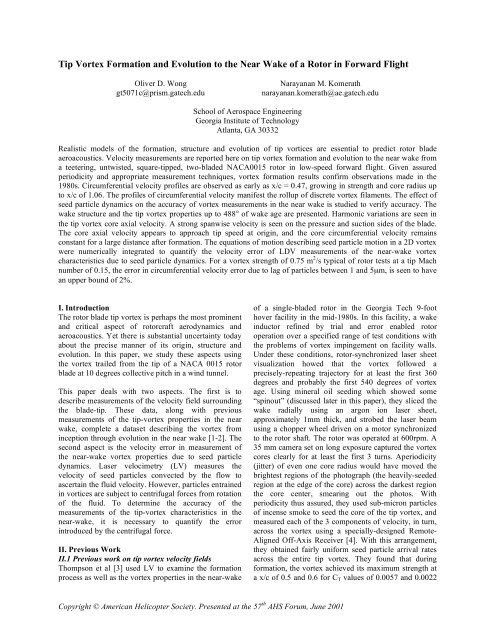
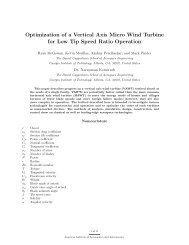
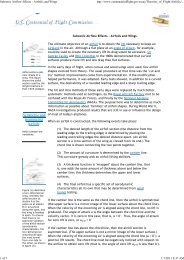

![p density of fluid, kg/m3 [Greek letter rho] V mean velocity of fluid, m ...](https://img.yumpu.com/50595898/1/184x260/p-density-of-fluid-kg-m3-greek-letter-rho-v-mean-velocity-of-fluid-m-.jpg?quality=85)
